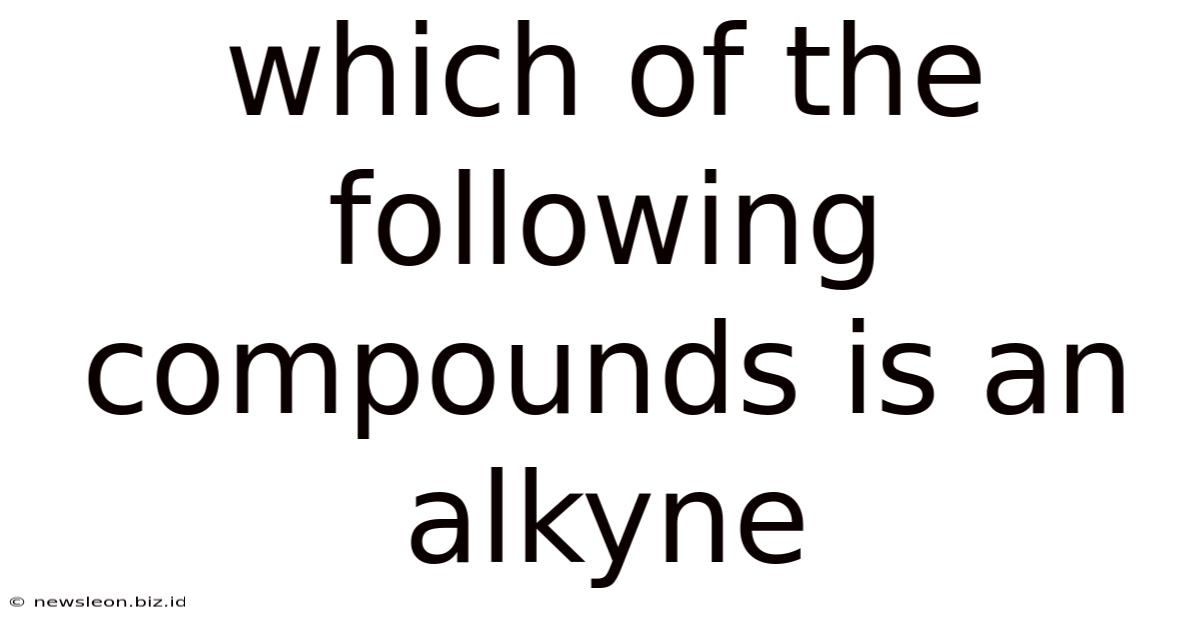Which Of The Following Compounds Is An Alkyne
News Leon
May 05, 2025 · 5 min read

Table of Contents
Which of the Following Compounds is an Alkyne? A Deep Dive into Alkynes and Their Identification
Identifying alkynes amongst a group of organic compounds requires a solid understanding of their unique structural characteristics. This article will delve deep into the definition of alkynes, explore their properties, and provide a comprehensive method for identifying them, even within a complex mixture of organic molecules. We'll examine various examples and explain the reasoning behind classifying a compound as an alkyne.
Understanding the Basics: What is an Alkyne?
An alkyne is a type of hydrocarbon, meaning it's composed solely of carbon and hydrogen atoms. What sets alkynes apart is the presence of at least one carbon-carbon triple bond (C≡C) within their molecular structure. This triple bond is the defining characteristic of alkynes and dictates many of their chemical and physical properties.
Key Characteristics of Alkynes:
- Unsaturated Hydrocarbons: Alkynes are unsaturated hydrocarbons because they contain fewer hydrogen atoms than the corresponding alkane (a hydrocarbon with only single bonds). The triple bond represents a region of high electron density, making alkynes more reactive than alkanes.
- Linear Geometry: The carbon atoms involved in the triple bond exhibit linear geometry, meaning the atoms bonded to the triple-bonded carbons are arranged in a straight line.
- Reactivity: The presence of the triple bond makes alkynes highly reactive. They readily undergo addition reactions, where atoms or groups of atoms are added across the triple bond, breaking it down to form new bonds.
- Nomenclature: Alkynes follow a systematic naming convention based on the number of carbon atoms in the parent chain. The suffix "-yne" is used to indicate the presence of a triple bond. For example, ethyne (C₂H₂) is the simplest alkyne.
Identifying Alkynes: A Step-by-Step Approach
Let's outline a step-by-step approach to identifying alkynes from a given list of compounds. Imagine we have the following compounds:
- CH₃CH₂CH₃ (Propane)
- CH₃CH=CH₂ (Propene)
- CH₃C≡CH (Propyne)
- CH₃CH₂OH (Ethanol)
- CH₃COOH (Ethanoic Acid)
Step 1: Identify Hydrocarbons:
First, filter out any compounds that are not hydrocarbons. Hydrocarbons only contain carbon and hydrogen. In our example, Ethanol (CH₃CH₂OH) and Ethanoic Acid (CH₃COOH) contain oxygen, so they are not alkynes.
Step 2: Analyze the Carbon-Carbon Bonds:
Now, focus on the remaining hydrocarbon compounds. Examine the bonding between the carbon atoms:
- Single Bonds (C-C): These are characteristic of alkanes.
- Double Bonds (C=C): These are characteristic of alkenes.
- Triple Bonds (C≡C): These are characteristic of alkynes.
Step 3: Identify the Triple Bond:
Look for the presence of a carbon-carbon triple bond (C≡C). In our example, only propyne (CH₃C≡CH) possesses a triple bond. Therefore, propyne is the alkyne.
Step 4: Confirmation through Nomenclature:
The systematic naming of organic compounds can also aid in identification. Note the "-yne" suffix in propyne, confirming its alkyne classification.
Examples and Detailed Explanation
Let's analyze more complex examples to further solidify our understanding:
Example 1:
Which of the following is an alkyne?
A. CH₃CH₂CH₂CH₃ (Butane) B. CH₃CH=CHCH₃ (2-Butene) C. CH₃CH₂C≡CH (1-Butyne) D. CH₃CH₂CH₂OH (1-Butanol)
Solution:
- Butane (A) is an alkane (all single bonds).
- 2-Butene (B) is an alkene (contains a double bond).
- 1-Butyne (C) is an alkyne (contains a triple bond).
- 1-Butanol (D) is an alcohol (contains an oxygen atom).
Therefore, 1-Butyne (C) is the alkyne.
Example 2:
Identify the alkyne among these compounds:
A. C₆H₁₄ (Hexane) B. C₆H₁₀ (Hexene isomers possible) C. C₆H₈ (Hexyne isomers possible) D. C₆H₁₂O₆ (Glucose)
Solution:
The general formula for alkanes is C<sub>n</sub>H<sub>2n+2</sub>, for alkenes is C<sub>n</sub>H<sub>2n</sub>, and for alkynes is C<sub>n</sub>H<sub>2n-2</sub>.
- Hexane (A) fits the alkane formula (C₆H₁₄).
- Hexene isomers (B) fit the alkene formula (C₆H₁₂). Note that there can be several isomers with a double bond.
- Hexyne isomers (C) fit the alkyne formula (C₆H₁₀). Again, multiple isomers are possible.
- Glucose (D) is a carbohydrate, not a hydrocarbon.
Therefore, C₆H₈ (Hexyne isomers) represents the alkyne(s). There are several possible isomers with the formula C₆H₈, all containing a triple bond.
Distinguishing Alkynes from Alkenes and Alkanes
It's crucial to be able to differentiate alkynes from alkenes and alkanes. Here's a summary table highlighting their key differences:
| Feature | Alkane | Alkene | Alkyne |
|---|---|---|---|
| General Formula | C<sub>n</sub>H<sub>2n+2</sub> | C<sub>n</sub>H<sub>2n</sub> | C<sub>n</sub>H<sub>2n-2</sub> |
| Bonding | Single (C-C) | Double (C=C) | Triple (C≡C) |
| Saturation | Saturated | Unsaturated | Unsaturated |
| Reactivity | Low | Moderate | High |
| Suffix | -ane | -ene | -yne |
Practical Applications and Significance
Alkynes play a significant role in various fields:
- Polymer Chemistry: Alkynes are used as building blocks in the synthesis of polymers, which have applications in plastics, fibers, and coatings.
- Organic Synthesis: They serve as important intermediates in the synthesis of many other organic compounds, including pharmaceuticals and other fine chemicals.
- Fuel Technology: Some alkynes are used as fuels, particularly in welding and cutting torches.
Conclusion
Identifying alkynes requires a careful examination of their molecular structure, specifically looking for the presence of a carbon-carbon triple bond (C≡C). Understanding the nomenclature and the key differences between alkanes, alkenes, and alkynes is essential for accurate identification. The examples provided and the step-by-step approach outlined in this article equip you with the tools to confidently determine whether a given compound is an alkyne. Remember to always analyze the bonding pattern and use the systematic nomenclature to reinforce your identification. This knowledge is critical for anyone working in organic chemistry or related fields.
Latest Posts
Related Post
Thank you for visiting our website which covers about Which Of The Following Compounds Is An Alkyne . We hope the information provided has been useful to you. Feel free to contact us if you have any questions or need further assistance. See you next time and don't miss to bookmark.